COVID-19-related restrictions in 2020 caused the largest drop in carbon -dioxide emissions from energy use since World War II. As lockdowns ended and economic activity started again, by December, worldwide emissions were 2%, or 60 million tonnes, higher than the same month in 2019, according to new data from the International Energy Agency.
—
What is Happening?
- Emissions from energy fell by about 2 billion metric tons, of 5.8% in 2020, from the previous year, the equivalent of removing all of the EU’s emissions from the global total, according to the authors.
- Both the U.S. and EU saw emissions fall by 10%, with the steepest reductions seen in March, April and May. China was the only large economy that saw emissions increase, by 0.8% on an annual basis. Much of that rise came toward the end of the year. China’s emissions were 7% higher in December 2020 than they were in December 2019.
- In India, emissions rose above 2019 levels from September as economic activity improved and restrictions were relaxed. In Brazil, the rebound of road transport activity after the April low drove a recovery in oil demand, while increases in gas demand in the later months of 2020 pushed emissions above 2019 levels throughout the final quarter.
- The biggest drop in energy-use emissions came from transportation. The decline in oil use contributed more than half of the overall total, with half of that coming from road traffic and another 35% from grounded airplanes.
The authors write, “In March 2020, the IEA urged governments to put clean energy at the heart of their economic stimulus plans to ensure a sustainable recovery. But our numbers show we are returning to carbon-intensive business-as-usual. This year is pivotal for international climate action – and it began with high hopes – but these latest numbers are a sharp reminder of the immense challenge we face in rapidly transforming the global energy system.”
You might also like: China Looks To Start Online Carbon Trading by June
- Thankfully, electricity generated from solar and wind power reached a record 20% of the global energy mix for the first time, and electric vehicles sold in record numbers.
- As the world recovers from the pandemic, the IEA is concerned about a post-pandemic boom in carbon emissions. The speed with which energy demand returned as pandemic restrictions lifted “underscores the risk that carbon emissions will increase significantly this year,” the IEA wrote.
- Scientists estimate that emissions would have to plummet by 10% for the year before scientists could detect the reduction in the CO₂ concentration of the atmosphere, which has risen every year for decades.
Dr Fatih Birol, the IEA Executive Director, says, “If current expectations for a global economic rebound this year are confirmed- and in the absence of major policy changes in the world’s largest economies- global emissions are likely to increase in 2021. Nonetheless, there are still reasons for optimism. China has set an ambitious carbon-neutrality target; the new US administration has rejoined the Paris Agreement and is putting climate at the heart of its policy-making; the European Union is pushing ahead with its Green Deal and sustainable recovery plans; India’s stunning success with renewables could transform its energy future; and the United Kingdom is building global momentum toward stronger climate action at COP26 in November.”
Featured image by: Flickr

















